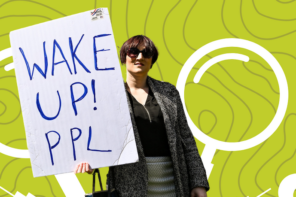Having stamped the barcodes of all milk produced at Russkoe Moloko with a red ‘X’ for the past five years owner Vasily Boyko-Veliky has finally explained why: Supermarket barcodes are the mark of the Anti-Christ described in Revelation and the ‘X’ is a actually cross.
As critics have pointed out, the cross makes no sense as a literal strategy for mitigating an end-times scenario since the dairy has still submitted to the Mark of the Beast. But it does make sense in the context of an ongoing struggle for legitimacy between millennial Christians and secular authorities. That is, the ‘X’ is a compromise that allows Veliky to sell his milk while publically performing his Christian identity and framing government regulators as Satanic and illegitimate.
Resisting the Mark of the Beast has long been an issue in American politics. In 2010 I reported on proposed state laws banning the forced implantation of microchips, which certain voters equated with the Mark. In Russia, barcodes are the chief object of millennial paranoia, with the three extended lines of the barcode equated with the number ‘6’. (This is slightly more plausible than the American conspiracy theory that the logo for Monster Energy Drink is not a claw mark, but three misshapen Hebrew letter ‘Vav’s, which hold a numerical value of 6). Some Russians apparently remove the barcodes from all of their groceries or else draw a cross over them. In 2008, a millennial group led by Orthodox priest Pyotr Kuznetsov, engaged in a standoff with Russian authorities, barricading themselves within a bunker because they believed that barcodes on food packaging are Satanic.
In a statement, Christian dairy tycoon Boyko-Veliky explained the crosses:
Russian Milk is forced to place bar codes on its packaging, as without this, we will only be able to sell our goods at farms, not in stores. . . . By placing the cross on the bar code, we want to demonstrate our stance: We are with our Lord, Jesus Christ, and not with the Antichrist and his servants.
Journalist Mark Bennets described this explanation as “a bit lame” since, regardless of the cross, Boyko-Veliky is still accepting the Mark of the Beast in order to buy and sell and becoming quite wealthy as a result. The agenda of Anti-Christ is not hindered by a few red ‘X’s on food packaging.
It does make sense, however, if we see the ‘X’ as a strategy for resolving competing visions of society. Although less radical than Kuznetsov, Boyko-Veliky has a vision of how society should be ordered and he imposes this order within his company. He has allegedly forced thousands of his employees to take Orthodox ethics lessons and threatened to fire anyone who has received or assisted in an abortion or who lives together “in sin.” But the mandatory barcode is a reminder that the government wields ultimate control over the social order. Instead of adopting the strategy of Kuznetsov, whose group burned their passports and credit cards and retreated to a bunker, Russkoe Moloko has found a way to compromise with government authority.
David Bromley has argued that violent episodes between government agencies and new religious movements—such as the immolation of the Branch Davidian headquarters in 1993—occur when “a movement and some segment of the social order reach a juncture at which one or both conclude that the requisite conditions for maintaining their core identity and collective existence are being subverted and that such circumstances are intolerable.” For certain Russian Orthodox Christians, the simple act of buying groceries is a constant reminder that the world is diametrically opposed to their culture and values.
Strategies for resolving this tension include accommodation (such as placing an ‘X’ over a barcode), retreat (such as Kuznetsov’s bunker), or contestation. Violence arises when these disputes continue to escalate. From this perspective, while placing an ‘X’ on barcodes may seem silly, it’s better than some of the alternatives.




